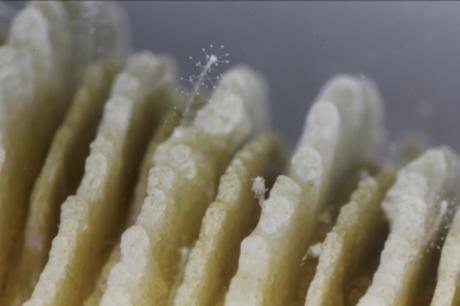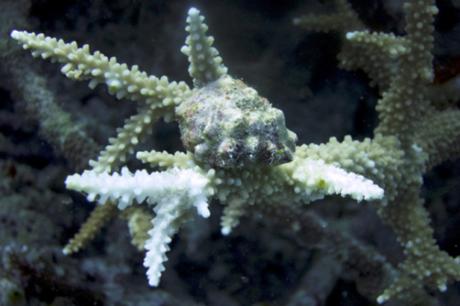
Hydrozoan polyps living on the surface of a coral (photo credit: S. Montano)
Corals could have some unexpected allies to cope with the multi-faceted threats posed by climate change.
In a new study published today in Proceedings of the Royal Society B, Montano and colleagues show how tiny hydrozoans smaller than 1 mm and commonly found in dense colonies on the surface of hard corals (see above photo) play an important ecological role.
Visually examining ~ 2500 coral colonies in both Maldivian and Saudi Arabian reefs, the scientists searched for signs of predation, temperature-induced stress, and disease. For each colony, they also recorded the presence of symbiotic hydrozoans. They demonstrated that corals living in association with hydrozoans are much less prone to be eaten by corallivorous (i.e., ‘coral-eating’) fish and gastropods than hydrozoan-free corals.
A likely explanation for this pattern could be the deterring action of hydrozoan nematocysts (cells capable of ejecting a venomous organelle, which are the same kinds found in jellyfish tentacles). An individual hydrozoan polyp of less than 1 mm clearly cannot cope with a corallivorous fish that is a billions of times larger, yet hydrozoans can grow at high densities on the surface of corals (sometimes > 50 individuals per cm2). This creates a sort of a continuous, ‘urticating‘ carpet that can discourage fish from foraging.

Corallivorous gastropod Drupella sp. feeding on a hard coral. The gastropod’s shell is in the center of the photo, and the white coral branches are dead coral skeletons resulting from the gastropod’s feeding.
This effect is even more apparent for corallivorous gastropods (Drupella spp.; see above). Intuitively, this is an obvious consequence of the gastropods’ locomotion (crawling), which exposes it to a more prolonged and intense contact with the hydrozoan nematocysts.
This has important implications for coral conservation because corallivorous gastropods are currently regarded as a major threat to reef persistence, due to the increasing frequency of outbreaks recorded around the world as a consequence of warming temperatures.
Montano and colleagues also found that the presence of symbiotic hydrozoans is negatively associated with the incidence of coral disease. This could be either a secondary effect of the reduction in risk of predation (because wounds opened by corallivorous can become easily infected by pathogens), and/or the result of a more active role of hydrozoans that could feed on pathogenic protozoans trying to invade coral hosts.
Despite their positive role, hydrozoans cannot counter the risk of coral mortality directly associated with increasing temperatures (i.e., coral bleaching), as demonstrated by the massive coral die-off recorded last year in the Great Barrier Reef. Yet, by improving the overall health of corals, hydrozoans probably play an important role in making reefs more resilient, possibly shifting the critical threshold between reversible and non-reversible damage.
If this is the case, this means that a microscopic, almost-invisible, and largely overlooked organism could be buying time for the half billion people relying on coral reef ecosystems for their subsistence. This is just another great example of great ecological things coming in small packages.
Giovanni Strona

